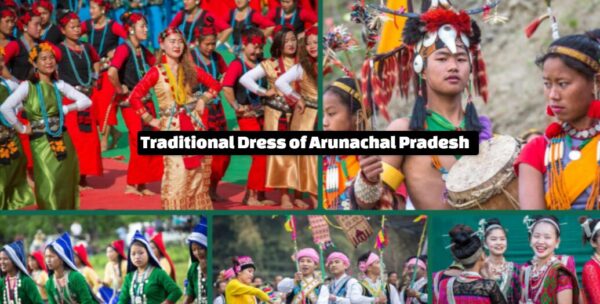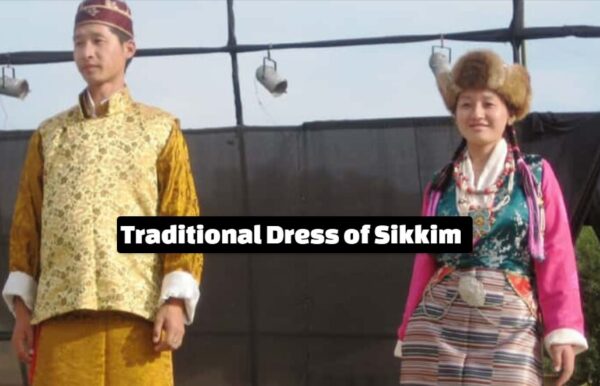The variety that is Arunachal Pradesh is evident in the weavings of its culture. Not just because the people who live here are respectful of the tradition they have grown up with and also want to incorporate the symbolism of these traditional and cultural intricate designs in their everyday life. This is the reason, if you travel to Arunachal there are both women and men wearing traditional clothes there most of the time. These dresses, considered the symbol of their ethnic identities and beliefs, can give you a glimpse into the stories that are not known to the Arunachal region. You will also discover that men’s clothes and women’s clothes have distinct characteristics. These are the information we will share with you on the identical.
Also Read: Traditional Dress of Sikkim
Arunachal Pradesh Traditional Dress for Men:
Arunachal Pradesh’s traditional dress for men is practical and cultural. Their elaborate headdresses and dazzling outfits represent the region’s diverse tribes.
1. Gale (Headgear):
Arunachali men’s hats, known as the Gale symbolize cultural identity and culture. Bamboo or cane, or other locally-sourced textiles create it the Gale more than clothes. It’s the past. The intricate designs of the Gale reflect the style of the wearer and more profound significance regarding tribal affiliations, social institutions, and religion. The shape of the Gale and its rich decorations reflect the wearer’s cultural background and status. Gale’s design highlights Arunachal Pradesh’s unique diversity. The size, design and ornaments reflect the state’s tribal traditions.
2. Tingmai (Upper Garment):
Teemamas, Arunachal Pradesh’s male top clothing, communicate the culture and identity. The sleeveless coat combines the function of a jacket with cultural significance. Tingmais, made of hand-woven fabric as well as animal skins showcase the skill and passion of the region as well as admiration for nature. Beyond aesthetics, the style and design are important to the culture. It is the Arunachali people’s deep ties to nature can be seen in the intricate Tingmai’s animal or tribal designs. The skill of Arunachal’s artists and exquisite shells, beads and threads help the Tingmai make a statement. Each ornament adds a significant element of Arunachali the traditional dress of men.
3. Baku (Lower Garment ):
Baku, also known as Galey, is Baku or Galey symbolizes the Arunachal Pradesh’s traditional clothes for men’s heritage and function. Wool or cotton underwear that is hand-woven blends the best of both worlds. The skirt-like design of the wraparound allows it to be easy to move around and comfortable on the rough terrain in the region. The cotton belt of Baku conforms to the waist, and it can be adjusted. Beyond its basic utility it is also a Baku is a showcasing or self-expression piece. Arunachali colors and patterns are a reflection of personal and tribal tastes. Beyond clothing beyond clothes, the Baku symbolizes strength and the ability to adapt. The continued use of the Baku in Arunachali male attire demonstrates the modernity of traditional tie.
Arunachal Pradesh Traditional Dress for Women:
Traditional Arunachal Pradesh woman’s attire showcases the traditional craftsmanship and culture of the region. Arunachal Pradesh women wear stunning elegant, sophisticated attires. Traditional attire includes:
1. Kong (Headgear ):
Women from Arunachal Pradesh sport the Kong to display their culture, just like men. Bamboo or cane, or even weaved fiber Kongs are stunning and innovative Arunachali craft. Beyond headwear the exquisite design and ornamentation expresses the pride and culture of the people who wear them. The beads, feathers and shells showcase their kinship and flair. The different styles of Kongs used by tribes and ornamentation reflect the diversity of Arunachal Pradesh’s culture. Kongs are a symbol of the status of a community and social status beyond their aesthetics. Arunachal women are proud to wear the Kong at all times during festivals, celebrations and every day life, blending tradition with modernity. A family’s heirloom reflects Arunachal’s heritage of indigenous people.
2. Yameng (Upper Garment):
Women from Arunachal Pradesh are awestruck by the Yameng top. Silk or cotton is made to create this big, sleeves-less, tunic or shirt. It’s a garment and a canvas to express your cultural as well as artistic expression. The exquisite embellishments make the Yameng. Local women’s artisans’ intricate embroidery mirror work, intricate stitching as well as exquisite designs of lace are found in every Yameng. These accessories enhance the clothes and showcase the region’s cultural. Yameng patterns and colors are a reflection of the natural surroundings tradition, culture, and customs. Animals, flowers and geometric patterns symbolize prosperity, fertility and identity in the culture, while bright colors symbolize the energy and wealth of the people.
3. Pati (Lower Garment):
Arunachal Pradesh women wear practical and richly culturally rich Pati. The hand-woven Patis are skirts that wrap around or curtains that are adorned with vibrant patterns, vibrant colors and tribal themes. The Pati that is fastened at the waist by the belt of cotton allows women to move freely throughout the diverse locations. It is suitable for both everyday and occasions. The diversity of tribes and Arunachali culture’s complexity is shown through pati length and design. A knee-length skirt is common However, certain tribes prefer knee-length dresses to show their cultural heritage.
Conclusion
In short it can be said that traditional attires that are worn in Arunachal Pradesh, worn by females and males, show the true character of the region by the quality and design. They are one of the most important aspects of the celebrations that are cultural and also. Similar to other regions of India, these dresses symbolize the essence of the state and people living there. A powerful tribute to the tradition of the land, these dresses continue to astonish the masses.




